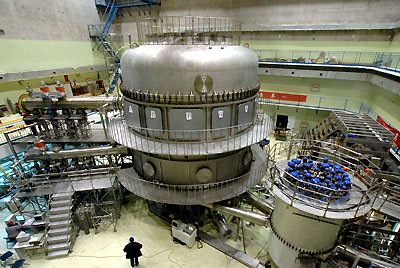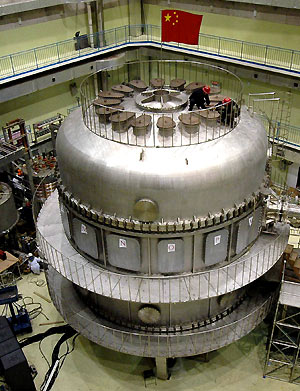| Tools: Save | Print | E-mail | Most Read |
| Test for Experimental Nuclear Reactor in July |
| Adjust font size: |
The first discharge tests of China's new generation experimental 'Tokamak' fusion device will be conducted July or August this year. If the experiments prove successful it would be the world's first experimental nuclear fusion device to come into operation. Li Jiangang, head of the Institute of Plasma Physics under the Chinese Academy of Sciences (CAS), and leader of the project, said on Tuesday that the enterprise is a "major move" for China to tap clean energy from nuclear fusion. China has provided the project, dubbed the Experimental Advanced Superconducting Tokamak (EAST), with an investment of 165 million yuan (about US$20 million).The EAST's final assembly has been completed. The device will be subject to vacuum, cooling and galvanizing experiments from February 20 to March. If the discharge experiment proves successful state inspection and approval according will follow according to routine procedures. According to Li, the EAST can create plasma with a temperature between 50 to 100 million Celsius degrees and a lifespan of 1,000 consecutive seconds. "Once successful in the discharge tests the EAST will be the first full superconducting experimental Tokamak fusion device ever put into operation in the world and will be unbeatable for at least a decade," Li said. In the mid 1980s, nations including the United States and the former Soviet Union launched an ambitious 10 billion-Euro plan -- the International Thermonuclear Experimental Reactor (ITER) -- which China became part of in 2003. "The EAST is the only prototype nearest to the ITER and thus it can serve advanced research in ITER in terms of engineering technology and physics," Li said. Using deuterium, which is in seawater, as fuel for reaction, a hydrogen plasma torus operating at over 100 million Celsius degrees will produce 500 megawatts of fusion power. The development of ITER is based on the idea of edging out non-recyclable mineral resources such as uranium and plutonium. All the commercialized nuclear reactors in the world were designed for fission -- a process different to the ITER's fusion -- and have to consume mineral resources such as uranium and plutonium which cannot be recycled. Waste from fission reactors are radioactive while the fusion reaction is a great deal more environmentally friendly. The EAST is an upgrade of China's first superconducting Tokamak device, dubbed HT-7, which was also built by the Plasma Physics Institute in 1994. The HT-7 made China the fourth country in the world, after Russia, France and Japan, to have such a device.
(Xinhua News Agency March 2, 2006) |
| Tools: Save | Print | E-mail | Most Read |
 |
| Related Stories |
|
| Product Directory China Search |
Country Search Hot Buys |


